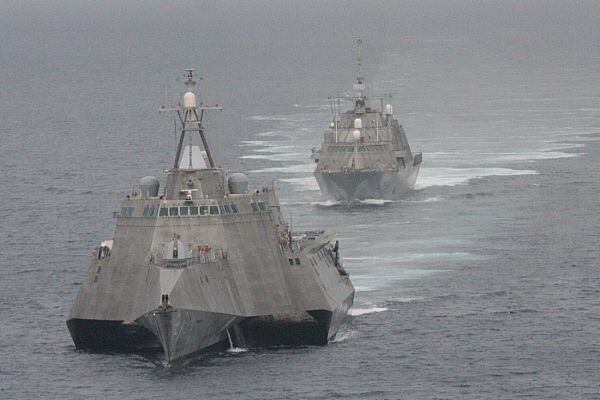After years of criticism, debate and angst, the US Navy appears to — finally — have embraced the littoral combat ships that will prove to be a critical element of its surface force.
To address persistent concerns that both versions of the speedy warship were too lightly armed and vulnerable, Defense Secretary Chuck Hagel ordered the Navy to study alternatives and capped the program at 32 ships.
Unsurprisingly, the Navy proposed adding weapons and improving the survivability of the last 20 ships of the class, referring to them as small surface combatants.
Critics maintain the changes will do little to improve the utility of the LCS while increasing unit cost by tens of millions of dollars apiece.
Supporters say the program is on time and budget and that LCS offers an ideal foundation as a potent future warship that will provide flexible forward presence and assume key minesweeping duties when current ships are retired in about a decade. They contend the shallow-draft ships will prove valuable, as in the search for the wreckage of the AirAsia jetliner.
To make the ships more attractive and help assimilate them more quickly into a skeptical fleet, Navy Secretary Ray Mabus last week announced that the ships would be redesignated as frigates. The decision comes as the last of the Navy's once-ubiquitous Oliver Hazard Perry-class guided-missile frigates are decommissioned after decades of exemplary service.
The announcement at last week's Surface Navy Association's annual conference and tradeshow outside Washington, however, did little to assuage skeptics who were quick to point out that the term frigate is usually applied to warships with multiple built-in capabilities.
The Perry-class ships had anti-submarine gear, a bigger gun and air defense missiles. None of these capabilities come standard on LCS hulls, which are delivered with a single 57mm gun.
All that said, the LCS is here to stay and it is critical that the right steps are taken to ensure the program's success.
First, both LCS designs will benefit from the distributed lethality concept to improve the fleet's firepower. A top priority is a new lightweight, long-range missile to give the ships an offensive punch.
Second, changeable mission modules are core to the LCS design, so the Navy must ensure the mine warfare, anti-surface and anti-submarine modules work and can be rapidly swapped as needs change.
Third, as the ships require more people to operate than originally expected, the Navy must determine the appropriate crew size and make the design changes needed to accommodate them.
Fourth, consider modifications to increase range and persistence.
Finally, equip the ships with a gun that is more powerful than the 57mm weapon now fitted, which many consider too small for the job.
The LCS is far different in fundamental approach than past ships. The Navy and its contractors must work hard to improve capabilities of both types of ships, which have limitations. Half the fleet will be a steel monohull by Lockheed Martin and Marinette Marine and the other half an aluminum trimaran by Austal USA. Adding weapons and systems on either one without compromising performance or driving other costly changes will be a challenge.
The right way to map the future LCS frigates is to get ships to the fleet where commanders and sailors can operate them to determine future capabilities while taking advantage of a fast, light warship designed for engagement, presence and limited combat in relief of larger, more powerful ships.
The Navy has signaled it is all-in with LCS. Now leadership must dedicate itself to ensuring this massive investment is a success.








